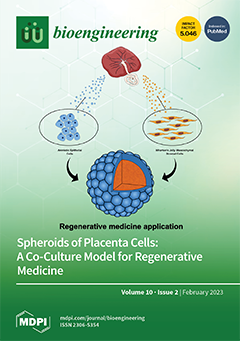In recent years, green nanotechnology has gained considerable importance for the synthesis of nanoparticles due to its economic viability and biosafety. In the current study, silver nanoparticles were synthesized using two bacterial isolates, H2 and H3, which were isolated from soil samples collected
[...] Read more.
In recent years, green nanotechnology has gained considerable importance for the synthesis of nanoparticles due to its economic viability and biosafety. In the current study, silver nanoparticles were synthesized using two bacterial isolates, H2 and H3, which were isolated from soil samples collected from the Western Ghats, Tamil Nadu, and identified at the species level as
Pantoeastewartii (H2) and
Priestiaaryabhattai (H3) by sequencing their 16s rRNA genes. Intracellularly synthesized silver nanoparticles were characterized by UV–visible spectroscopy, Fourier transform infrared spectroscopy, atomic force microscopy, and particle size analysis. AFM studies show that both of the bacterial synthesized Ag NPs were circular-shaped and disaggregated, with an average size distribution of 4 nm for
Pantoeastewartii and 3.6 nm for
Priestiaaryabhattai. Furthermore, their larvicidal activity, antimicrobial, histopathological, and biotoxicity effects were determined. The synthesized Ag NPs exhibited potent larvicidal activity against fourth instars of
Ae.aegypti,
An.stephensi, and
Cx.quinquefasciatus exposed to a 50 µg/mL concentration for 24 h based on their LC
50 and LC
90 values. Histopathological studies of the affected mosquito larvae clearly show damage to the epithelial cells, food bolus, basement membrane, muscles, and midgut parts. The maximum antimicrobial activity of
Priestiaaryabhattai-synthesized Ag NPs was observed for
Streptomyces varsoviensis MTCC-1537, and that of
Pantoea stewartii-synthesized Ag NPs was against
Escherichia coli MTCC-43. The toxicity test on non-target organisms such as
Artemia nauplii and zebrafish embryos indicates no visible abnormalities or mortality after their exposure for 48h. It is concluded that silver nanoparticles can easily be synthesized using
Pantoea stewartii (H2) and
Priestia aryabhattai (H3) as capping and reducing agents. Silver nanoparticles showed potent larvicidal activities and could potentially be used in integrated vector control programs because they are safe for other inhabitants of the same aquatic environment as mosquito larvae.
Full article






